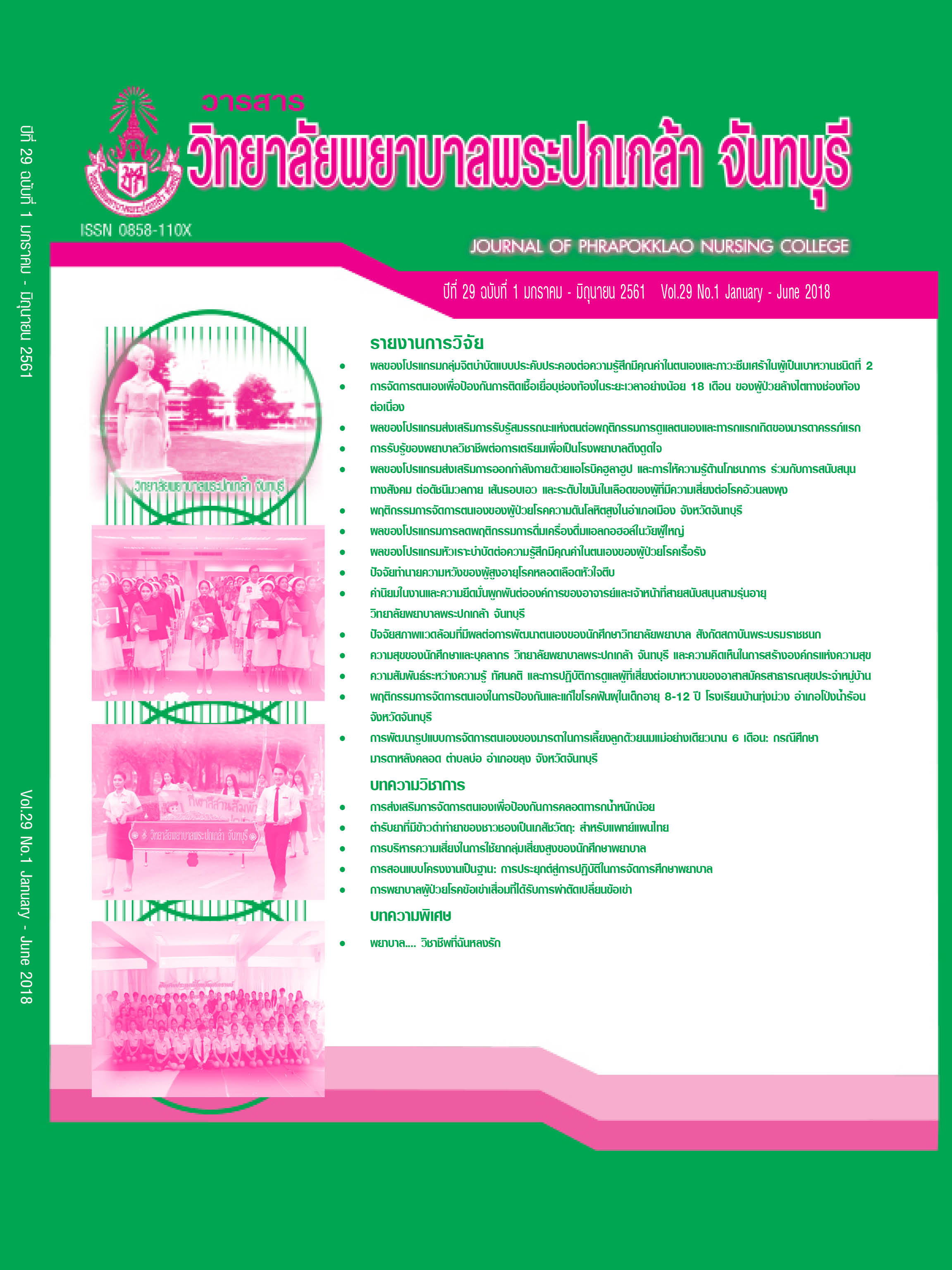The Effects of Reduced Alcohol Consumption Behavior Program in Adulthood
Keywords:
Alcohol consumption behavior, Knowledge, Motivation, Skill to refuse alcoholAbstract
This quasi-experimental research aimed to examine the effects of reduced alcohol consumption behavior program in adulthood. The samples consisted of 80 male adults who lived in Ban Bua Sub-district, Mueang District, Buriram Province and were equally divided into an experimental group (n = 40) and a comparison group (n = 40). The research instruments included a reduced alcohol consumption behavior program, a questionnaire of demographic data, a scale of knowledge regarding health effect with the reliability of .78, a scale of motivation to avoid alcohol with the reliability of .81, a questionnaire of skill to refuse alcohol with the reliability of .71, and a scale of alcohol consumption behavior with the reliability of .86. The implementation and data collection were conducted from November, 2015 to January, 2016. Statistics used for data analysis included frequency, percentage, Chi-square test, Fisher’s exact test, paired t-test, independent t-test, and repeated measure ANOVA with multiple comparisons by Bonferroni.
The research results revealed that: 1) after the program, the experimental group had statistically significant higher average scores of knowledge regarding health effect and skill to refuse alcohol than before the program (t = 8.034, p < .001 and t = 4.710, p < .001, respectively); 2) after the program, the experimental group had statistically significant higher average scores of knowledge regarding health effect, motivation to avoid alcohol, and skill to refuse alcohol than the comparison group (t = 9.775, p < .001; t = 2.965, p < .01 and t = 4.107, p < .001, respectively); and 3) after the program and follow-up stage, the experimental group had statistically significant lower average scores of alcohol consumption behavior than before the program (p < .001) and lower than the comparison group.
This research suggested that related agencies should apply this reduced alcohol consumption behavior program concerning special knowledge seeking, motivation promotion, and skill practice relevant to each area context.
References
กรมสุขภาพจิต กระทรวงสาธารณสุข. (2554). รายงานประจำปี กระทรวงสาธารณสุข. สืบค้น 24 มกราคม 2557, จาก http://180.180.246.10/ULIB//dublin.php?ID=738#.VD9D1aRirIU
ทักษพล ธรรมรังสี, และคณะ. (2556). ผลการศึกษาความสัมพันธ์เกี่ยวกับพฤติกรรมการดื่มเครื่องดื่มแอลกอฮอล์กับการบาดเจ็บที่มาเข้ารับการรักษาที่แผนกอุบัติเหตุฉุกเฉิน (รายงานผลการวิจัย). นนทบุรี: ศูนย์วิจัยปัญหาสุรา.
นงนุช ตันติธรรม. (2549). ปัจจัยที่มีความสัมพันธ์กับพฤติกรรมการดื่มสุราของผู้ขับขี่ที่เมาสุราแล้วขับรถในเขตกรุงเทพมหานคร (วิทยานิพนธ์ปริญญามหาบัณฑิต). กรุงเทพฯ: มหาวิทยาลัยเกษตรศาสตร์.
นิพนธ์ พัวพงศกร, และคณะ. (2548). โครงการวิจัยพัฒนารูปแบบเพื่อการป้องกันการดื่มสุราและเครื่องดื่มแอลกอฮอล์ (รายงานผลการวิจัย). กรุงเทพฯ: สถาบันวิจัยเพื่อการพัฒนาประเทศไทย.
บัณฑิต ศรไพศาล, และคณะ. (2556). รายงานสถานการณ์สุรา ประจำปี พ.ศ. 2556. กรุงเทพฯ: ศูนย์วิจัยปัญหาสุรา.
ปริทรรศ ศิลปกิจ, และพันธุ์นภา กิตติรัตนไพบูลย์. (2552). แบบประเมินปัญหาการดื่มสุรา แนวปฏิบัติสำหรับสถานพยาบาลปฐมภูมิ ฉบับปรับปรุงครั้งที่สอง. กรุงเทพฯ: ทานตะวันเปเปอร์.
ปริทรรศ ศิลปกิจ, และพันธุ์นภา กิตติรัตนไพบูลย์. (2556). รายงานคณะกรรมการผู้เชี่ยวชาญองค์การอนามัยโลกด้านปัญหาจากการบริโภคแอลกอฮอล์ (รายงานครั้งที่ 2). ม.ป.ท.
สมพร รุ่งเรืองกลกิจ, อิงคฏา โคตนารา, และศิริพร จิรวัฒน์กุล. (2555). เริ่มดื่มสุราเป็นเรื่องง่าย...แต่แสนลำบากในการเลิกดื่มสุรา. วารสารพยาบาลศาสตร์และสุขภาพ, 35(2), 1-14.
สวรรยา สิริภคมงคล, และคณะ. (2552). การป้องกันการดื่มเครื่องดื่มแอลกอฮอล์ของวัยรุ่น. วารสารประชากร, 2(3), 7-24.
เอกชัย กันธะวงศ์, สุมาลี เลิศมัลลิกาพร, และอะเคื้อ อุณหเลขกะ. (2558). การพัฒนาการป้องกันการดื่มเครื่องดื่มแอลกอฮอล์ในนักเรียนมัธยมศึกษาตอนต้นโดยการมีส่วนร่วมของโรงเรียน. พยาบาลสาร, 42(3), 135-146.
Bloom, B. S., Hastings, J. T., & Madaus, G. F. (1971). Handbook on formative and summative evaluation of student learning. New York: McGraw-Hill Book.
Cochran, W. G. (1977). Sampling techniques (3rd ed.). New York: John Wiley & Sons. Retrieved November 29, 2016, from https://scholar.google.com/citations?user=uCYQp-YAAAAJ&hl=th&oi=sra
Djoussé, L., & Mukamal, K. J. (2009). Alcohol consumption and risk of hypertension: Does the type of beverage or drinking pattern matter?. Revista Espanola de Cardiologia, 62(6), 603-605. DOI: 10.1016/S1885-5857(09)72223-6.
Fisher, J. D., & Fisher, W. D. (1992). The IMB Model, HIV prevention for positives, and adherence. New York: Institute of Human Development and Social Change.
Fleming, M., Brown, R., & Brown, D. (2004). The efficacy of a brief alcohol intervention combined with %CDT feedback in patients being treated for type 2 diabetes and/or hypertension. Journal of Studies on Alcohol, 65(5), 631-637.
Kunz, F. M., French, M. T., & Bazargan-Hejazi, S. (2004). Cost-effectiveness analysis of a brief intervention delivered to problem drinkers presenting at an inner-city hospital emergency department. Journal of Studies on Alcohol, 65(3), 363-370.
Lock, C. A., et al. (2006). Effectiveness of nurse-led brief alcohol intervention: A cluster randomized controlled trial. Journal of Advanced Nursing, 54(4), 426-439.
World Health Organization. (2004). Guidelines for drinking-water quality. Geneva: WHO publications.
Downloads
Published
How to Cite
Issue
Section
License
Copyright (c) 2018 Journal of Phrapokklao Nursing College

This work is licensed under a Creative Commons Attribution-NonCommercial-NoDerivatives 4.0 International License.
เนื้อความ ข้อมูล และรายการอ้างอิงที่ผู้เขียนใช้ในการเขียนบทความเพื่อลงตีพิมพ์ในวารสารวิทยาลัยพยาบาลพระปกเกล้า จันทบุรี ถือเป็นความคิดเห็นและความรับผิดชอบของผู้เขียน คณะผู้จัดทำวารสารไม่จำเป็นต้องเห็นพ้องด้วยหรือร่วมรับผิดชอบ
บทความที่ได้รับการลงตีพิมพ์ในวารสารวิทยาลัยพยาบาลพระปกเกล้า จันทบุรี ถือเป็นลิขสิทธิ์ของวารสารวิทยาลัยพยาบาลพระปกเกล้า จันทบุรี หากหน่วยงานหรือบุคคลใดต้องการนำส่วนหนึ่งหรือทั้งหมดของบทความไปเผยแพร่ต่อเพื่อวัตถุประสงค์ใด ๆ จะต้องได้รับอนุญาตจากบรรณาธิการวารสารก่อน



